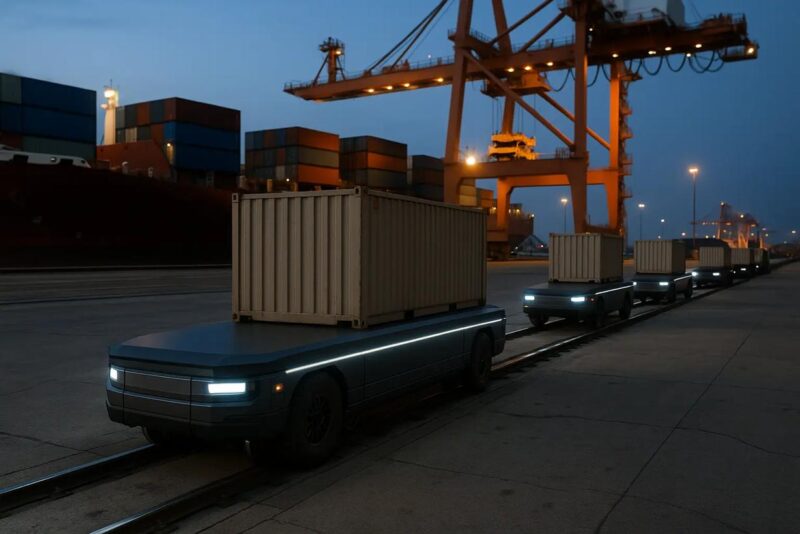Glīd Tech’s Patented Intermodal Transfer System Brings Efficiency and Safety to First and Last Mile Logistics
Glīd Tech
Logistics is a complex and big business. From ports to yard-rail and and short-haul trucking to cross-country rail and long distance trucking – the amount of transfers from one mode of transport to another is highly varied and complex, and requires a lot of expensive equipment, software and trained labor. Glīd Tech (pronounced “Glide”), a California based company, aims to simplify this, especially for small batch, short distance (first or last mile) logistics through a combination of hardware, software and physical AI (Artificial Intelligence).
The company is the brainchild of CEO Kevin Damoa, who has had various logistics roles as a U.S. Army veteran, SpaceX, Northrop Grumman (F-35), Canoo, and XOX trucks. The positions involved shipping and retrieving large items via road and rail. He also worked as an industrial designer at Harley-Davidson. Through these experiences, he realized that existing processes and infrastructure for transitioning goods from road to rail were incredibly complex and inefficient involving load/unload equipment like forklifts and cranes, creating high latency in delivering goods to end customers.
Glīd Tech was founded in 2021 to solve this problem and enable efficient inter-modal transfers for short range logistics, using existing rail and road infrastructure. The company recently closed a pre-seed funding round ($3.1M) with Draper U Ventures, Outlander VC, Antler, The Veteran Fund and M1C.
Short mileage logistics is crucial for the manufacturing revolution in the U.S.A. Small and medium size businesses need to transport their product to customers without facing the huge barriers that delay their goods delivery and revenue realization – this is what happens if they need to rely on current day rail networks optimized for large trains with > 50 train cars powered by expensive engines and train crew, transporting goods across 3000 miles. Glīd short-circuits this and makes small batch deliveries affordable and efficient. It also addresses some of the stress points faced by the $1T/year rail and road logistics business in the United States today – shortage of truck drivers, rail capacity under-utilization, intermodal terminal bottlenecks, labor safety issues, and economic inefficiencies of this massive business. Glīd uses physical AI, AoT™ (Autonomy of Things) and robotics to accelerate Blue Collar Autonomy, something that has been implemented in construction, agriculture, mining, airport logistics, quarrying and solar farm construction which face similar pressures – lack of skilled labor able to work safely and efficiently in remote and harsh conditions. It uses its hardware and software platforms to provide MaaS (Mobility as a Service) to end customers.
Mr. Damoa’s vision has translated into an inter-modal platform, the Rāden, an autonomous hybrid-electric vehicle approximately 8 feet wide, 22 feet long, and 4.5 feet high. A patented mechanism enables a dual-mode (rail or road) operation via an autonomous mobility stack that transitions seamlessly between road and rail while maintaining stability across varied terrain. Figure 1 is a schematic of how this mechanism operates.
Figure 1: Schematic of the Rāden an autonomous hybrid-electric vehicle designed for road and rail transportation Top Figure: Road Operation, Bottom Figure: Rail Wheels Move Down and Elevate Road Wheels
Glīd Tech
How does lateral movement occur in the rail-to-road and road-to-rail frictionless Glide? The trick is to rotate all wheels at coordinated angles enabling sideway or diagonal movement at low speeds (5 mph). Figure 2 is a visual description of how this is achieved.
Figure 2: Seamless Lateral Transition from Road to Rail
Glīd Tech
Another key aspect of the Rāden is omni-directional operation. All wheels are independently actuated, enabling enable movement in any direction without changing the vehicle’s orientation. This is a fundamental departure from conventional truck steering, and essential for the precision positioning required during autonomous rail engagement. It also provides significant operational efficiency advantages. Rāden works in concert with EZRA-1SIX, Glīd’s AI-powered software. It integrates perception and control architecture with rail-adapted mechanical systems, redefining the boundaries of autonomous logistics. The on-road and off-road autonomy is provided through a collaboration with a U.S. based autonomy stack provider that services military and commercial applications. Rail based autonomy is a joint collaboration with the same provider.
The autonomy stack consists of:
Geospatial Mapping and Topography Modeling: High-definition LiDAR, radar, and camera arrays generate 3D surface maps of both track and terrain, resolving grade, curvature, and elevation to centimeter-level precision. This allows the vehicle to anticipate transitions—such as approaching a rail switch, incline, or uneven surface—and adjust in real time.
Perception and Rail Inspection: AI vision models conduct continuous visual rail inspections, identifying misalignments, wear, or debris on the track. These insights feed predictive maintenance and routing systems through Glīd’s EZRA-1SIX logistics control platform.
Dynamic Load Stabilization and Transition Control: When shifting from rail to road—or entering austere environments—the vehicle engages a hydro-pneumatic suspension and active load-balancing system. This manages elevation shifts and uneven terrain while preserving cargo integrity for loads up to 40,000 pounds. The control stack uses feedback loops between the perception layer and drive-by-wire actuators to maintain equilibrium during mode transition.
Energy-Aware Route Planning: The planning layer optimizes routes across both networks, balancing traction requirements, grade, and regenerative braking opportunities to extend operational range and reduce energy demand.
Together, these systems enable Glīd’s autonomous vehicles to operate safely and efficiently in mixed-mode environments—from rail yards and industrial parks to unpaved or disaster-affected regions where infrastructure is limited.
Glīd overcomes the stress points faced by logistics providers by delivering efficient short mile solutions to small and medium size businesses, accelerating the re-vitalization of American manufacturing (not just semiconductors and computers, but somewhat heavier physical stuff). It’s solutions deliver more than 50% operating cost reduction versus conventional diesel trucks with under 2.5-year customer payback, while enabling access to remote rail infrastructure previously unreachable by conventional freight vehicles. CEO Kevin Damoa: “This is a historic moment. We’re not just building vehicles, we’re synchronizing road and rail with atoms and bits. The next generation of logistics is not man versus machine, but man and machine operating as one – unmanned systems guided by human values. That is what we stand for.”
Great Plains Industrial Park – Revitalizing U.S. Industrial Revolution
This is one of the customers that Glīd is running pilot programs at. Located in the American heartland (Parsons, Kansas, population 9500), midway between Kansas City, Kansas (150 miles north), and Tulsa, Oklahoma (120 miles south), on a former Army base (27 square miles in area and 26 miles of rail track), the Great Plains Industrial Park provides turnkey infrastructure and large green field development opportunities suited for utilities, manufacturing, and logistics industries while offering unique innovation opportunities for partners like Glīd. The park is managed by the GPDA (Great Plains Development Authority) whose goal is to spur the local industrial economy and employment, enabling people to reside and work in the area, and add to the tax base and economic prosperity of the region. 50% of the of the park is occupied by Days Zimmerman, which manufactures tank shells for the U.S. Department of War. The other 50% is occupied by small businesses (about 50).
Union Pacific operates at a significant frequency (26 trains per day) on their railroad tracks outside the park, and connects with the rail tracks inside the park. The challenge for business tenants is moving their products to appropriate load and unload points to access these long distance trains. One of the business operated in the park is wind power generation. Figure 3 shows the effort required to load and unload wind turbine components during an installation in 2020.
Figure 3: Transload of Wind Power Components from 71 Train Wagons to 7,200 trucks At Great Plains Industrial Park in 2020
Great Plains Industrial Park
This is a case study of how Glīd could reduce complexity in intermodal load, move & unload process It can also provide short distance, short latency logistics for goods and materials for local businesses and interface with the Union Pacific network for long range logistics. Glīd would have the ability to move any commodity on rail or road within the park and transport loaded rail wagon cars outside the park on a rail siding for a Union Pacific pick up.
Brad Reams is the Director of the Great Plains Industrial Park. Rather than the phrase “Blue Collar Autonomy”, he refers to the Glīd capability as an instrumental enabler for Purple Collar Autonomy (logistics workers like truck drivers, crane operators and rail engineers). Per Mr. Reams, “When GPDA took possession in 2012, it was always the plan to go back to our roots, which was an active logistics and manufacturing location. It is our desire to develop a purple collar job economy. Glīd Technologies’ last mile transportation solutions allows us to achieve these goals. Businesses are provided advanced logistics solutions which sustain economic success and allow for full employment in a previously underserved area of the American Heartland”.
Mendocino Railway – A Legacy of Rail
This is another customer that Glīd is performing a pilot with. Mendocino Railway is a Class III public utility common carrier railroad, that manages short distance railway lines in rural areas of Northern California. It is regulated by the Surface Transportation Board. These include California Western Railroad (CWR) in Mendocino County (on which the Skunk Train has been providing railroad services since 1885, Figure 4), Sacramento River Train / River Fox Train, which operates along the Sacramento River, and the Sunburst railroad operation on the Santa Paula Branch Line. It is a for-profit entity, regulated by the Surface Transportation Board, and delivers freight transport, excursion, and commuter passenger services.
Figure 4: The Skunk Train is a historic, 1885 Institution, originally part of the Fort Bragg Railroad for transporting lumber. The Skunk moniker was coined in 1925 due to the odor created by the fuel used to run the engine and heat compartments. Today the Skunk offers excursions through Northern California’s Redwood forests (without the odor!)
Mendocino Railway
Robert Pinnoli, the CEO, is a passionate train lover and views railway lines such as these as a lifeblood for rural communities and business to get their goods to end users quickly and efficiently (per Mr. Pinnoli, short haul, Class III rail can move 1 ton of freight a distance of 500 miles/gallon of diesel, 50X more efficient than trucks, which would consume 50 gallons). Using rail to explore the wonders of Northern California’s forests and coastline is another passion of Mr. Pinnoli (serves 100,000 passengers/year).
Mr. Pinnoli is also looking constantly for technological progress to maintain the affordability, profitability,relevance and access for transportation logistics for local businesses. This is where Glīd comes in. Figure 5 shows a concept for the GlīderM, built on the Rāden platform, currently under development for the pilot.
Figure 5: Concept for GlīderM Dual Mode Vehicle for Mendocino Railway
Glīd Tech
The relevance of the Glīd Tech collaboration is to demonstrate safe operation on road and rail (the initial pilot will have humans in control, autonomy could be tested in the future). Assuming a successful pilot, the plan is to use the technology to deliver goods containers by rail, and reach an end point (say an Amazon warehouse) by road for the last mile. It will also be used to move containers to load/unload points for long distance railway lines. Per Mr. Pinnoli: “This partnership captures the spirit of the Skunk Train—timeless in its roots, bold in its future. We’re excited to work alongside Glīd to chart a path forward where innovation and tradition not only coexist but thrive.”
Newlab – Venture Platform for Critical Technology
Newlab is a venture platform for nurturing and growing start-ups in critical technology areas. It was founded in 2016 in Brooklyn, New York and subsequently built locations in Detroit and South America (2023). Upcoming locations include Saudi Arabia and New Orleans.
The focus is on hard-tech and supporting innovation that revitalize local industries in areas like manufacturing, mobility, logistics, space, agriculture and infrastructure. Managed by a board consisting of founders, scientists, engineers, investors, and operators, the focus is on helping critical technology founders to build and grow their businesses. It does this by providing access to infrastructure (labs, tool rooms, prototyping facilities, etc.), investment capital, and facilitating projects with industrial and government partners.
Newlab Detroit leads the charge to redefine mobility, manufacturing, and the industrial economy from the ground up. Anchored at Michigan Central and surrounded by one of the country’s most storied industrial communities, the focus is on leveraging the local DNA to accelerate innovation in mobility, manufacturing and logistics.
For Glīd Tech, Newlab Detroit is a natural fit. The company participated at a recent event there called Move America. Many mobility companies (start-ups and established) participated. Glīd displayed the Rāden platform and communicated the message of revolutionizing intermodal logistics.
Figure 6: Glīders (that is what Glīd employees are called) and Rāden on Display at Move America, Newlab Detroit
Glīd Tech
The Centropolis Accelerator is associated with Newlab Detroit and focuses on hard-tech. In partnership with the Gilbert Family Foundation, it conducts a 12-week program for founders developing physical products and hardware-enabled solutions. Its advisors help validate product-market fit, demonstrate early commercial traction through pilots, de-risk design and engineering, and prepare for scalable commercialization. Colleen Hau is and Advisor-in-Residence here, as well as at Newlab Detroit, and is mentoring Glīd Tech through this program.
Ms. Hau believes that Michigan has what it takes to build high value, hard-tech products profitably given the local talent pool, supply chains, support industries and infrastructure. This is the sweet spot for Glīd to prototype, test and scale their hardware platforms to high TRL/MRL (Technology/Manufacturing Readiness Levels). The ability of Glīd’s platform to disaggregate freight into smaller and faster chunks is a boon for small businesses and critical for fueling the re-industrialization of America. “Glid is at the forefront of hard tech and reindustrialization in Michigan, seamlessly merging autonomous, electrified transport with logistics innovation. By bridging road and rail, they are not only redefining efficiency, safety, and sustainability in the logistics sector but also setting a new standard for American manufacturing and technological advancement.”









